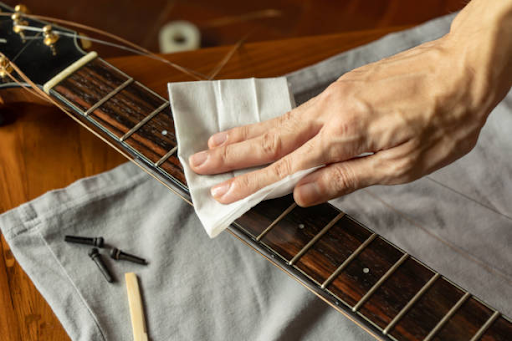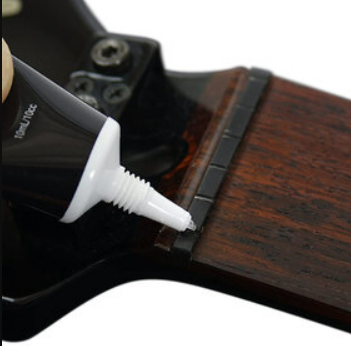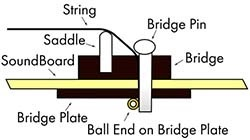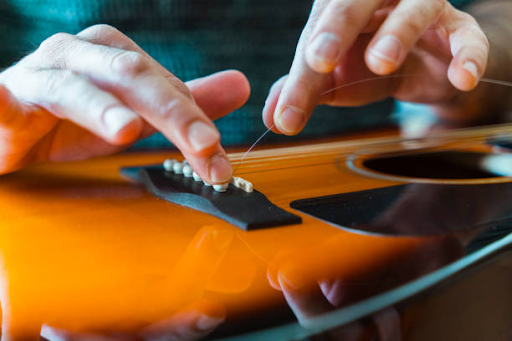7 Top Tips for Acoustic and Classical Guitar Maintenance
Our acoustic and classical guitars are made with high-quality materials and construction, so if looked after and maintained well you can enjoy your new instrument for many years. Taking good care of your gear and observing a few general upkeep practices is the best way to extend the life of your instrument, plus your guitar will play and feel better.
Neglecting to clean and take care of your gear can cause drastic failure, and you’ll find that very little effort can go a long to way preserve your guitar. Putting a little effort into general maintenance can also save time and money in the long run.
1. Change those Rusty Strings!
The strings are probably the easiest thing to take care of on your guitar, and they are certainly the most important - you’ll have a hard time playing without them! We all sweat and secrete natural oils from our fingertips, which can build up on the strings and cause breakage sooner, make the strings feel sticky, rusty, or sharp, and eventually dull your tone. The easiest way to mitigate this is to simply wipe down your strings with a soft cloth before and after using the guitar, and try and play with clean, dry hands.
It is best practice to change your strings frequently. The amount of time left between changes will vary depending on your individual needs are as a player, but if there are dirty or rusty spots, kinks or any sharp areas on the string it is definitely time for a restring. We have some fantastic resources to help you change your strings if you need some guidance.
- Rusty or dirty strings are a sign that you need new strings
- Older strings are more likely to break, and don’t sound the same
- Wiping your strings after use can extend their lifespan
- Wash your hands before playing and avoid greasy fingers from food
2. Fretboard Care and Oiling will keep your guitar feeling smooth

There are many types of frets and fretboard materials, and learning how to keep these in good shape will make your guitar feel much better under your fingers! Just like with strings, keeping your fretboard clean and free from grime is very important.
Darker exposed wood necks such as Rosewood or Laurel can benefit from occasional oil treatment to help retain some moisture, and if your fretboard is particularly dry or showing signs of cracking consider oiling and conditioning your fretboard. If your fretboard is made of maple, or if it has a lacquer finish, you do not need to ever use oils, just a wipe down with a soft cloth when you’re strings are off will suffice.
Frets shouldn’t need too much upkeep, but they will wear down over time. Keeping clean and fresh strings without rust will ensure that they last longer, and occasionally polishing and buffing your frets can ensure they wear evenly, and will prevent sharp spots building up, which can easily break strings.
- Only use guitar-safe oils, food products and other household oils should not be used on guitar fretboards. We have some great options like this planet waves lemon oil
- Never oil a Maple fretboard, or one that has a lacquer finish
- Avoid dropping your guitar or leaning it against hard surfaces with the fretboard facing downwards. This can cause dents, kinks and damage to your strings and fret wires
- Buffing and polishing your frets will make your bends feel smooth, and help prevent string breakage. We recommend Music Nomad FRINE fret polish
3. Nut Maintenance Goes a Long Way!
If you ever hear a creaking noise from your strings whilst tuning your guitar, it just means the string is getting caught in the nut. This can make tuning more difficult and will mean your guitar will probably need to be tuned more frequently, it can even cause strings to break.

- Using any normal pencil, gently rub the tip of the pencil graphite in the empty nut slot
- With graphite flakes in the nut slot, wipe away any excess from around the edge of the nut
- Re-string and tune your guitar
- Alternatively, we offer long-lasting, professional nut lubricant here
This will ease the passing of the string through the nut slot, meaning your tuning will be smooth and without any creaking noise. If this does not resolve your issue, the nut slots may be too narrow for your strings and may need to be re-filed; this is a job best left to a professional. This is common if you’ve recently changed which string gauge you’re using, and is easily remedied with any good set-up.
4. How to Spot Tuning Problems and How to Fix Them
If you’re having issues, there could be a number of reasons why your guitar is frequently going out of tune. The machine heads, nut and saddle as well as strings and their installation are all common causes of tuning problems on a guitar.
Make sure you have a good understanding of how to change your strings, we have some great resources on our blog to help you, or reach out to us if you need some extra tips!
Here are some common issues to check at the machine heads first, and below are some further tips for different guitar styles.
- Not enough string has been wound onto the tuning peg, and the string is slipping
- Too much string has been wound on the tuning peg, and it’s difficult to turn. The ideal here is 3-4 full turns of the machine head, or 1 layer of string wound around the peg
- Uneven winding or gaps between string windings on the peg, which can cause slipping. Wind your string symmetrically and do not cross the string over your previous windings.
- Faulty Machine heads. If the worm gear inside the machine head is broken it may not be turning correctly or causing slippage
For Acoustic Steel String Guitars:
- The ball-end of the string must be bent in a 'banana' shape before inserting it into the bridge pin holes
- Once the ball-end is inside, insert the pin and push down whilst pulling the string back simultaniously. This will ensure that the ball-end is sitting snuggly underneath the sound board (or top of the guitar), and maximise your tonal transfer!

For Classical Nylon-String Acoustic Guitars:
- Make sure you have made a secure knot-tie once inserting the string into the machine head
- Make sure that you have made a secure winding pattern knot-tie with the string in the bridge slots
- Monitor these knots as you tune up, if they start to slip or come undone then stop tuning and start again
5. Stretch those strings!
This should be the final step of any string change, and taking the time to stretch your strings can save you a lot of time re-tuning as they settle in. Carefully pulling on your strings helps remove the slack at the machine head, it will mitigate some of the natural flexing, and on an acoustic guitar it also helps to settle the string into the sound board.

- With your guitar in tune, pluck an open string
- Starting near the bridge, pull the string outwards and away from the body of the guitar. You should aim to put some tension on the string, and may find you can pull this up a few inches. Do not tug roughly at the string, just gently apply outwards pressure
- Repeat this a few more times, moving up the fretboard in intervals towards the headstock
- When stretching the string near the nut with one hand, use your other hand to push down on the string near the machine head. This will settle down the wind and prevent any slipping
- Pluck the same open string, you will probably find the string has detuned, and you have successfully stretched the string. Tune up again, and repeat the process for this string if necessary
- Carefully repeat this process for the rest of your strings
For steel string acoustic guitars with bridge pins, place one finger over the bridge when stretching the strings. As you pull on the string you may notice the ball-end slip beneath the pins, that's a good sign as the ball-end should be against the guitar top (sound board). Re-tune that string and repeat the stretching process.
6. Hardware Maintenance (You’ll thank us later)
General cleanliness will go a long way to help your guitar last a long time, but with any normal use the hardware will eventually start to wear from sweat and the natural oils we produce from our hands. If your guitar has metal hardware, you’ll eventually notice rust and grime buildup. This is totally normal, but isopropyl alcohol and a stiff cotton bud is enough to handle most cleaning for general maintenance, and a gentle, patient hand will keep your hardware sparkling.
- Gently clean metal areas with a soft but firm cotton bud and Ispopropyl alcohol before rust has a chance to take hold and a restoration is in order!
- If you have one, clean around the guitar output jack using the same method, you can clean inside too but don’t go digging for gold in there, the wiring shouldn’t be poked at
- Tighten your output jack bolt carefully if it is loose, do not let the jack twist around as you do so as this can damage the internal wiring
- Clean your cable-tips! If your cables see a lot of use at gigs or practice, they can be the cause of rust and grime buildup inside your guitar output jack. Clean these occasionally and they will last longer too
7. Read our Other Resources!
We have some fantastic resources on our website to help you with set up, adjusting your truss rod, setting your action and intonation, plus string-change info on various bridge types (including correct Floyd Rose setup!). If you’re having issues in any of these areas please feel free to contact our helpful team and we’ll do all we can to assist you.
- Getting a professional set up is recommended at least once. It will show you the true potential of your instrument and reveal issues you may have never noticed before, and can never live with again!
- Set ups are generally quite affordable, but learning a few techniques to get your guitar set up nicely by yourself can save you money, it is quite enjoyable, and it is the best way to get your guitar playing the right way for you, and to your personal specifications
- Buzzing frets, slipping machine heads, correct intonation, neck relief, action and pickup height can all be fixed with very few tools. Issues such as flat frets with dead-spots, wiring issues, pickup swaps or nut refitting may take more precision tools and know-how
- If you’re experiencing issues with the set up of your Artist guitar, reach out and we’ll do our best to troubleshoot and advise however we can

